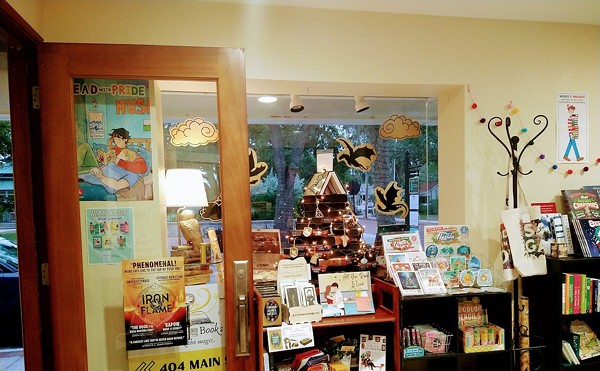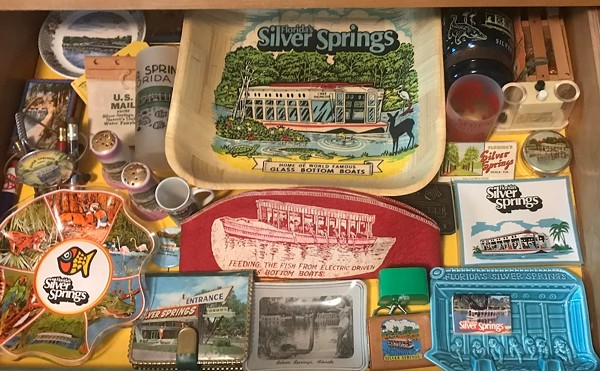People say never to forget 9/11. I won’t. On the morning of Sept. 11, 2001, I was working on the 30th floor of a high-rise in midtown Manhattan. We had a great view of the World Trade Center towers until around 9:15 a.m., when evacuation began.
I learned a lot— didn’t we all?— in the subsequent months. That the President of the United States wasn’t above using a national tragedy for political gain. (I’m sorry, but what else can you call George W. Bush’s grandstanding at Ground Zero?) That late 2001 was not a fun time to be Muslim-American for a lot of folks. (Just ask some of my friends.) And that in a climate of fear, every person is a suspect and every package is suspicious.
Through June 24, an exhibit at the Tampa Bay History Center called Spies, Traitors, Saboteurs: Fear and Freedom in America serves as a reminder that such concerns are far from new in the course of U.S. history. On loan from the International Spy Museum in Washington, D.C., the exhibit highlights acts of politically-motivated violence from colonial times to the present, along with the sometimes dubious reactions those acts have inspired, through an array of historical objects, informational panels, interactive activities, photographs and films.
Starting with struggles between British loyalists and U.S. nationalists (the former plotted to kidnap George Washington, perhaps with the help of a turncoat), the exhibit traces nine periods of political unrest over more than 200 years. These include WWI-era destruction of New York’s harbor by German agents; Pearl Harbor and its aftermath of internment camps and discrimination against Japanese-Americans; panic over Communism at home and abroad during the Cold War; and Timothy McVeigh’s Oklahoma City bombing and other home-grown terrorism.
What’s interesting about the show is its provocatively even-handed approach. The spies, traitors and saboteurs of the exhibit’s title are not always definitively identified as such. Anarchists of the 1910s and 20s— among them Emma Goldman, who advocated for women’s rights but also may have inspired Leon Czolgosz to assassinate William McKinley — are proffered to visitors both as dangerous extremists and as idealists concerned with exploitative labor conditions. The young Weatherman Bernardine Dohrn earns a spot on the FBI’s 1970 most wanted list; thirty years later, she appears in a documentary that treats the group’s Vietnam-era activities, including bombings, with calm neutrality.
There are plenty of exceptions — the KKK, which the exhibit points to as the U.S.’s most enduring hate group is framed, appropriately, as pure villainy. (Three Klan robes, including a child-sized one, and stomach-turning calling cards that read “You’re next” make for one of the exhibit’s most macabre displays.) McVeigh gets no sympathy either. But in general visitors are tasked with answering tough questions like, what would I do in the shoes of the Haymarket bomber or a Black Panther in 1969? (Alternatively, what would you do as J. Edgar Hoover in 1969? When our government responds to dissent, or worse, by ordering surveillance against its own citizens, who’s betraying whom?)
A viewer who already has fixed opinions about such things will be challenged by Spies, Traitors. If you fancy a rousing debate with your loved ones, this exhibit would be a good place to have one.
“People have said it leans too far to the left and too far to the right,” says Rodney Kite-Powell, the History Center’s curator. “We're all pretty sure that there are an equal number of people who have said both. There's never been an exhibit we've had that has elicited that kind of response.”
The portion of the exhibit devoted to Communism is one of the most playfully presented. An interactive wall of file cabinets invites visitors to check out government dossiers on celebrities suspected of communist sympathies during the 1940s and 50s. Eleanor Roosevelt’s 3,271 page file — summarized on a graphic panel — reveals letters written in protest to the House Committee on Un-American Activities, the Congressional group whose pursuit of Hollywood communists has been compared to a witch hunt. Per the file, Roosevelt imagined that cooperation between the U.S. and Russian communists could end the Cold War.
To grasp how radical her perspective might have seemed, stop and watch “Red Nightmare,” a black-and-white film produced by the Department of Defense in 1962. The melodrama depicts the horror of Jerry, the father of an idealized American family, as his loved ones are brainwashed by communism. In a climactic scene, Jerry drags his kindergarten-aged children, who have pledged their loyalty to the Party, to a church only to find it transformed into a museum dedicated to Soviet history. Much later, he wakes up from his nightmare.
The film is comical now, in a chilling sort of way, but it was taken seriously enough in 1962 to be broadcast on CBS and screened in public schools.
As propaganda, it finds a peculiar match in a video on display at the conclusion of Spies, Traitors. Placed next to the exhibit segment commemorating 9/11, the video announces “We are under siege” over a montage of Middle Eastern faces. Interspersed interviews with experts on global relations offer somewhat more nuanced insights — specific groups of Islamic extremists endanger peace — but in visual terms the video conjures an “Arab nightmare” with about as much subtlety as the 1962 film. And this isn’t an historical object presented for critical consideration, but rather a didactic element of the exhibit like an informational panel.
Overall, I was least impressed by the exhibit’s take on 9/11, presented through a scant few objects. A pair of twisted hunks of metal described as fragments of hijacked airplanes join a paperback copy (the kind available from Amazon.com) of the 9/11 Commission Report and a bulletin board pinned with news stories about Osama bin Laden. The updatable board I appreciate as a clever solution to the problem of exhibiting as history an event that in some ways is still ongoing. (Bin Laden was killed while Spies, Traitors was on tour at the National Constitution Center in Philadelphia.)
But where’s the video, ubiquitous in 2001, of planes crashing into the World Trade Center, or office workers jumping out of the towers? Where’s a graphic of the Homeland Security Advisory System? (Remember the “orange alert” days?) Or a panel about discrimination against Muslim-Americans? (To the exhibit’s credit, that phenomenon is noted on a timeline overview at the exhibit’s entrance.)
I’d surely be asking similar questions about each event represented in Spies, Traitors if I’d lived through them all. Getting visitors to think like that — critically, about history and how it’s crafted — is the exhibit’s commendable achievement.
















